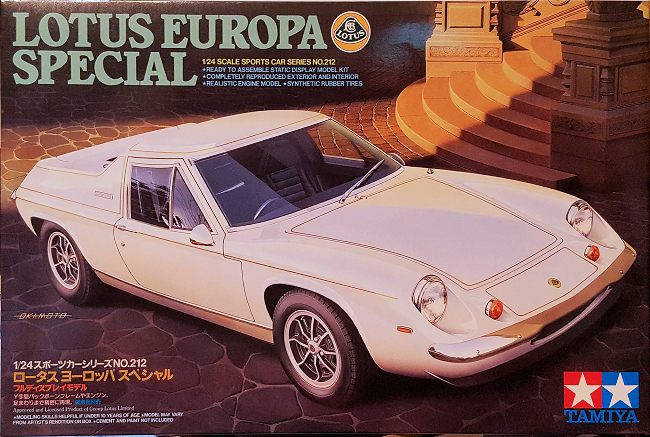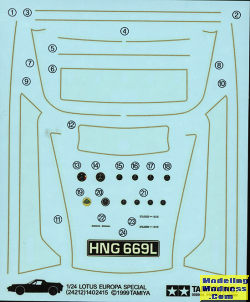
Tamiya 1/24 Lotus Europa Special
| KIT #: | 24212 |
| PRICE: | 2000 yen SRP |
| DECALS: | one option |
| REVIEWER: | Scott Van Aken |
| NOTES: | 1999 release |

| HISTORY |
By the mid-1960s, the mid-engine vehicle configuration was well-established as the optimal design for Grand Prix cars, however almost no road vehicles yet used this arrangement. Lotus planned the Europa to be a volume-produced, two-seater mid-engine sports coupe built to reasonable cost, quite an ambitious goal for the time. Like all Lotus vehicles of the era, the Europa was designed and built following Chapman's oft-stated philosophy of automotive design: "Simplify, then add lightness". To this end, a number of ingenious design approaches were made by Lotus to allow it to economically overcome the many challenges presented by the novel mid-engine arrangement.
Production of the original Lotus Europa ceased in 1975, with a total of 9,230 cars of all models having been built.
The Europa used a lightweight, folded & welded "minimalist" boxed-steel backbone chassis with a fibreglass moulded body, a combination that was first used by Lotus founder Colin Chapman in the Lotus Elan launched in 1962. Earliest versions of the Europa had the body fully bonded to the chassis for maximum structural stiffness, however this was soon changed to a bolted-on body to allow normal chassis and body repairs to be made. Unlike the Elan, the Europa had no front-mounted engine or gearbox to accommodate, and so the Europa's main chassis member ran straight forward to intersect a large box-section cross-beam running across the car between the front suspension points. At the rear, the chassis split into a "U" shape behind the cabin to accommodate the combined engine, transmission and final-drive components, and to support the rear suspension.
The sourcing of suitable engine, gearbox and final-drive components was considered critical to the success of delivering a low-cost mid-engine vehicle. Chapman was keen to diversify beyond the Ford components heavily used in earlier Lotus vehicles, and settled on using the engine and combined transmission/final-drive transaxle units recently released by Renault for their 16. The 1,470 cc (1.5 L) Renault engine was a light and modern design, while the matching Renault 16 transaxle seemed almost ideal for the Europa project. In the Renault, the transaxle sat ahead of the engine, driving the front wheels. By relocating the combined engine/transaxle unit to the rear of the car and rotating it 180 degrees in plan, Lotus could obtain a ready-made modern mid-engine configuration - albeit one with four reverse gears. By repositioning the differential crownwheel within the final drive assembly, the direction of rotation of the output shafts was reversed, thus correcting this shortcoming.
The Renault 16's engine's design met Lotus's requirements. It used an aluminium block with cast-iron cylinder liners, which saved appreciable weight compared to the cast-iron blocks more common at the time. Its overhead-valve design had the camshaft located high-up in the block, resulting in a compact valve-train well suited for high-rpm operation. Most importantly, all the engine ancillaries (water pump, belt-drives, alternator) were driven off a v-belt pulley fixed to the transaxle end of the camshaft instead of being driven by the engine's crankshaft. When fitted to the Europa, this pulley location put all the engine's ancillaries at its rear face giving easy access for maintenance, rather than them being located against the vehicle's bulkhead as-for most conventional engines.
For Lotus' use, the Renault engine was given a number of key improvements, including a higher compression ratio (10.25 instead of 8.6), larger inlet valves, revised valve timings, dual valve springs and a twin-barrel carburettor. These changes lifted the engine's power by 23% from 63 hp (47 kW) at 5,000 rpm to 82 hp (61 kW) at 6,000 rpm. For US export, a de-tuned 1,565 cc (1.6 L) version with a maximum output of 80 hp (60 kW) at 6,000 rpm was fitted.
Later, Europa models were fitted with the same Ford-based Lotus TwinCam engine used in the Elan range since 1962. This was a sophisticated, twin-overhead-cam, 8-valve high-performance engine rated at 105 hp (78 kW) in original (Euro) specification (later uprated to 126 hp (94 kW) in "big-valve" form). It was reported that Lotus initially delayed its introduction in the Europa until they were confident in the strength of the Renault transaxle. The twin-cam engine first appeared in the Europa engine bay in mid-1971 (in Europe) and early 1972 (in North America).n North America, both the (early) 1972 Twin Cam version and (late) 1972–1974 Twin Cam "Special" versions were rated at 113 hp (84 kW) in Federalized Form.
When Renault introduced their most powerful 16 TX model in 1973, it included a strengthened 5-speed transmission. Lotus quickly offered this gearbox as an option in the Europa, along with their Big Valve twin-cam engine.
| THE KIT |
Tamiya's kit is boxed as the big valve twin cam engine. This is the 'Special'. Typically, the molding is world class and you are offered a very nicely done engine, which will benefit from careful painting. Once done, the suspension bits are assembled, some of which attach to the engine. The wheels are held in place with polycaps and the front is designed to be able to turn. Tires are rubber/vinyl.
Then the engine is installed in the chassis and these
parts are attached before initial work is done on the floor pan. Once the
chassis is attached to the floor pan, the intake manifold is attached to the
engine and work begins on the interior. You are provided a bevy of decals for
the instrument panel. The car is right
 hand drive
as benefits those sold in Europe and Japan. A section of mesh is provided for
the front grille opening and then this along with the lower rocker panels are
attached to the body as well as the windows. Assuming you have put the interior
door panels in place properly, the body simply slides onto it. Final pieces are
the engine hood, which also takes some mesh sections, as well as the headlights,
bumpers and the like. .
hand drive
as benefits those sold in Europe and Japan. A section of mesh is provided for
the front grille opening and then this along with the lower rocker panels are
attached to the body as well as the windows. Assuming you have put the interior
door panels in place properly, the body simply slides onto it. Final pieces are
the engine hood, which also takes some mesh sections, as well as the headlights,
bumpers and the like. .
Instructions are very nicely done as expected from Tamya and as usual, all the paint numbers are from the Tamiya line. The decal sheet provides basically instruments, trim and a license plate. While the box art is a white car, looking on the 'net shows a number of other colors used.
| CONCLUSIONS |
This is a nice addition to Tamiya's 1/24 sports car series. The Europa is a neat little car and deserves to be in any collection of these types of cars.
| REFERENCES |
https://en.wikipedia.org/wiki/Lotus_Europa
August 2021 Copyright ModelingMadness.com.
All rights reserved. No reproduction in part or in whole without express
permission. If you would like your product reviewed fairly and
fairly quickly, please
contact
the editor or see other details in the
Note to
Contributors.